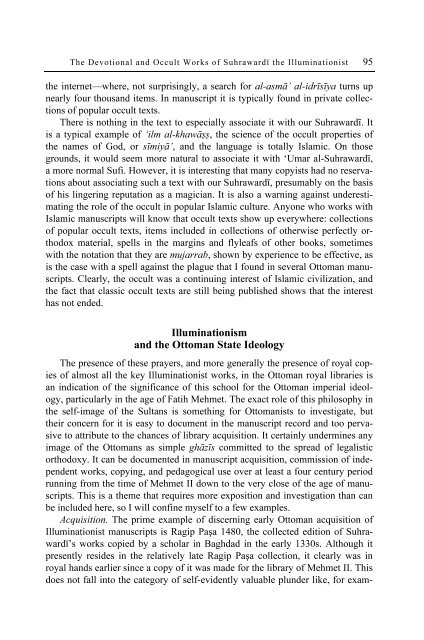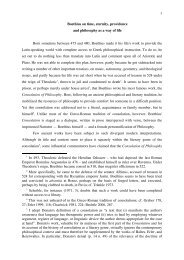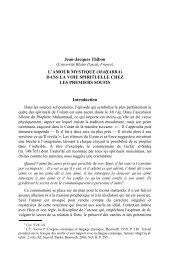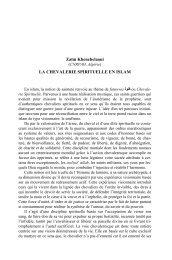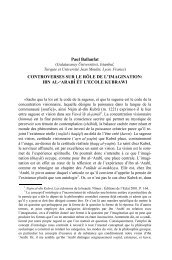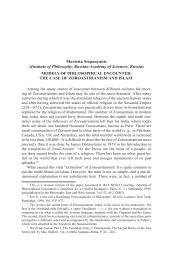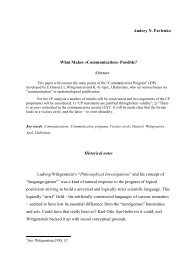The Devotional and Occult Works of Suhrawardī the Illuminationist
The Devotional and Occult Works of Suhrawardī the Illuminationist
The Devotional and Occult Works of Suhrawardī the Illuminationist
You also want an ePaper? Increase the reach of your titles
YUMPU automatically turns print PDFs into web optimized ePapers that Google loves.
<strong>The</strong> <strong>Devotional</strong> <strong>and</strong> <strong>Occult</strong> <strong>Works</strong> <strong>of</strong> <strong>Suhrawardī</strong> <strong>the</strong> <strong>Illuminationist</strong> 95<br />
<strong>the</strong> internet—where, not surprisingly, a search for al-asmā’ al-idrīsīya turns up<br />
nearly four thous<strong>and</strong> items. In manuscript it is typically found in private collections<br />
<strong>of</strong> popular occult texts.<br />
<strong>The</strong>re is nothing in <strong>the</strong> text to especially associate it with our <strong>Suhrawardī</strong>. It<br />
is a typical example <strong>of</strong> ‘ilm al-khawāṣṣ, <strong>the</strong> science <strong>of</strong> <strong>the</strong> occult properties <strong>of</strong><br />
<strong>the</strong> names <strong>of</strong> God, or sīmiyā’, <strong>and</strong> <strong>the</strong> language is totally Islamic. On those<br />
grounds, it would seem more natural to associate it with ‘Umar al-<strong>Suhrawardī</strong>,<br />
a more normal Sufi. However, it is interesting that many copyists had no reservations<br />
about associating such a text with our <strong>Suhrawardī</strong>, presumably on <strong>the</strong> basis<br />
<strong>of</strong> his lingering reputation as a magician. It is also a warning against underestimating<br />
<strong>the</strong> role <strong>of</strong> <strong>the</strong> occult in popular Islamic culture. Anyone who works with<br />
Islamic manuscripts will know that occult texts show up everywhere: collections<br />
<strong>of</strong> popular occult texts, items included in collections <strong>of</strong> o<strong>the</strong>rwise perfectly orthodox<br />
material, spells in <strong>the</strong> margins <strong>and</strong> flyleafs <strong>of</strong> o<strong>the</strong>r books, sometimes<br />
with <strong>the</strong> notation that <strong>the</strong>y are mujarrab, shown by experience to be effective, as<br />
is <strong>the</strong> case with a spell against <strong>the</strong> plague that I found in several Ottoman manuscripts.<br />
Clearly, <strong>the</strong> occult was a continuing interest <strong>of</strong> Islamic civilization, <strong>and</strong><br />
<strong>the</strong> fact that classic occult texts are still being published shows that <strong>the</strong> interest<br />
has not ended.<br />
Illuminationism<br />
<strong>and</strong> <strong>the</strong> Ottoman State Ideology<br />
<strong>The</strong> presence <strong>of</strong> <strong>the</strong>se prayers, <strong>and</strong> more generally <strong>the</strong> presence <strong>of</strong> royal copies<br />
<strong>of</strong> almost all <strong>the</strong> key <strong>Illuminationist</strong> works, in <strong>the</strong> Ottoman royal libraries is<br />
an indication <strong>of</strong> <strong>the</strong> significance <strong>of</strong> this school for <strong>the</strong> Ottoman imperial ideology,<br />
particularly in <strong>the</strong> age <strong>of</strong> Fatih Mehmet. <strong>The</strong> exact role <strong>of</strong> this philosophy in<br />
<strong>the</strong> self-image <strong>of</strong> <strong>the</strong> Sultans is something for Ottomanists to investigate, but<br />
<strong>the</strong>ir concern for it is easy to document in <strong>the</strong> manuscript record <strong>and</strong> too pervasive<br />
to attribute to <strong>the</strong> chances <strong>of</strong> library acquisition. It certainly undermines any<br />
image <strong>of</strong> <strong>the</strong> Ottomans as simple ghāzīs committed to <strong>the</strong> spread <strong>of</strong> legalistic<br />
orthodoxy. It can be documented in manuscript acquisition, commission <strong>of</strong> independent<br />
works, copying, <strong>and</strong> pedagogical use over at least a four century period<br />
running from <strong>the</strong> time <strong>of</strong> Mehmet II down to <strong>the</strong> very close <strong>of</strong> <strong>the</strong> age <strong>of</strong> manuscripts.<br />
This is a <strong>the</strong>me that requires more exposition <strong>and</strong> investigation than can<br />
be included here, so I will confine myself to a few examples.<br />
Acquisition. <strong>The</strong> prime example <strong>of</strong> discerning early Ottoman acquisition <strong>of</strong><br />
<strong>Illuminationist</strong> manuscripts is Ragip Paşa 1480, <strong>the</strong> collected edition <strong>of</strong> Suhra-<br />
wardī’s works copied by a scholar in Baghdad in <strong>the</strong> early 1330s. Although it<br />
presently resides in <strong>the</strong> relatively late Ragip Paşa collection, it clearly was in<br />
royal h<strong>and</strong>s earlier since a copy <strong>of</strong> it was made for <strong>the</strong> library <strong>of</strong> Mehmet II. This<br />
does not fall into <strong>the</strong> category <strong>of</strong> self-evidently valuable plunder like, for exam-


